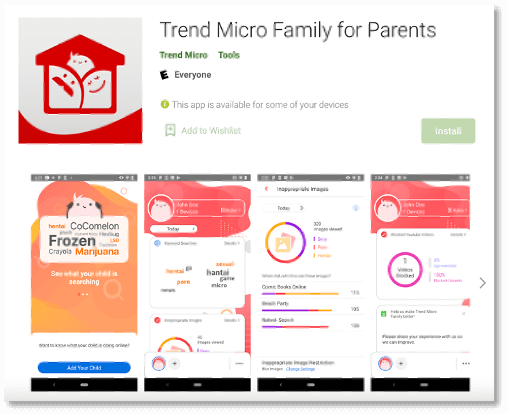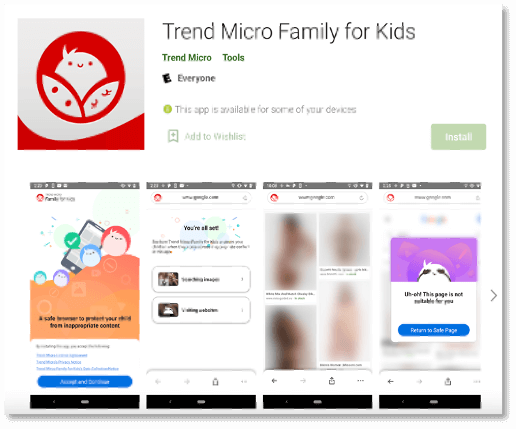New Toys
Ever since Myspace and Facebook launched in the early-mid 2000s, social media has become an increasingly ubiquitous feature of modern living, particularly in children and teenagers.
According to research from Common Sense Census, 56% of children have their own social media accounts, based on the parents’ survey responses. Among those children, parents reported that the average age when joining a social media platform was as young as 12.
The same group warns that too much screen time can place children and teens at risk of obesity, sleep problems, cyberbullying, poor academic performance, and depression and anxiety — Trend Micro Family’s Social Media Checker is an exciting new tool designed to protect against precisely these concerns (see below for how it works).
In line with this, 65% of parents surveyed by Pew Researchers said they worry about their kids and excessive screen time. In 2015, 67% of teens ages 13 – 18 had their own smartphone. By 2019, the number had steadily grown to 84%. While Facebook used to dominate, Snapchat is now the most used social media platform among kids and teens, followed by TikTok and Instagram.
Pros & Cons
The key takeaway is that social media is here to stay — for better or for worse. It is fair to say there are equal positives and negatives.
Positives:
- Staying connected with friends (particularly during Covid-19)
- Meeting new friends with shared interests
- Finding communities and support for specific activities or personal issues
- Sharing art work, music, and other passions
- Exploring and expressing themselves, creatively and safely
Negatives:
- Exposure to harmful content (sex, drugs, violence etc.)
- Likewise to dangerous people
- The risk of cyberbullying, and its relation to depression and suicide
- Oversharing of personal information
- Exposure to excessive advertisements and distractions
- Privacy concerns including the collection of data, not to mention identity theft
- Interference with sleep, exercise, homework, family activities etc.
For the reasons above, it’s important to practice safe and prudent social media behaviors. As parents or guardians, you don’t want to create an environment in which cyberbullying and online predation thrive. Nor do you want random strangers being to contact or have access to your personal lives and those of your children.
Equally important, you want to firmly demarcate the boundary, or dividing lines, between real and virtual life — but also draw attention to how they do intersect, for example, ignorant old Twitter posts that may come back to haunt you. Parents, guardians, and figures of authority have a responsibility to have these discussions with children and teens.
Communication Is Key
It’s important to prepare our children and teens for the online world, a place that (despite its deceptive simplicity) can be even more dangerous and confusing than “real” life. We need to discuss online dos and don’ts — to communicate media literacy. Here are some suggestions to get the conversation going:
1. Set the tone. Begin your talk in a calm, neutral way — and stay calm.
2. Ask before you tell. Ask your child what apps or platforms they use. In a sense, you’re entering the child’s arena: let them guide you too.
3. Lead by example. Being honest and transparent will help them trust you in serious moments. Regarding positive examples, we covered a similar point in our recent Digital Detox article.
4. Run through the positive and negative aspects above: reach consensus.
5. Talk about permanence and privacy. Let them know that what’s posted online is permanent.
6. Friending or following your child’s social media accounts.
7. Perhaps broach the topic of no-screen times and periodic detoxes.
8. Ensuring that privacy settings are turned on to limit access to personal information.
9. Instructing teens NOT to share sensitive information online — especially with strangers.
10. Exploring parental control apps that limit internet access in content and duration.
A Helping Hand from Trend Micro
Despite some of the pitfalls we have addresses, the majority of parents agree that social media is primarily a force for good. Check out the latest research from Digital Wellness Lab. Parents often feel they’re on their own when trying to guide their children through the digital world. That is why Trend Micro have been excited to announce their latest product, Trend Micro Family, a complimentary solution that has linked apps for both parents and the kids — as well as a simple Chrome extension for ease of use.


Its key features include:
- Social Media Checker: An industry-first, Trend Micro Family recommends the best security and privacy settings for your social media accounts, which ensure children aren’t accidentally or unknowingly exposing themselves to unwanted dangers on social media. Currently supporting Instagram, additional platforms such as TikTok and Facebook will be made available soon.
When was the last time you checked your privacy settings on social media platforms? Often, our default privacy settings are a lot less secure than we realize. Trend Micro Family will fix this. Upon entering your log-in details, the Social Media Checker will run a quick check and recommend the best security and privacy settings.
Why not give our Social Media Checker a quick look while you’re here? Follow the link to try it out.
- Safe Browsing: A less invasive approach, Trend Micro Family provides a safer online environment by blurring out explicit images in real-time, as well as preventing access to unsuitable sites while blocking unwanted ads.
- Personalized Settings: Families with multiple children can choose settings appropriate for each child.
- Screen Time Summary: Parents can see how their children are interacting with the internet.
- Visibility Reporting: Parents can get a deeper understanding of the interests and worries of their children, with feedback on their online searches.
Before we leave you, do also take a look at our Trend Micro Cyber Academy, an exciting interactive series for kids and their parents on internet safety and digital wellness. And if you’ve found this article a useful and/or interesting read, please do SHARE with family and friends to help keep our loved ones secure and protected.
